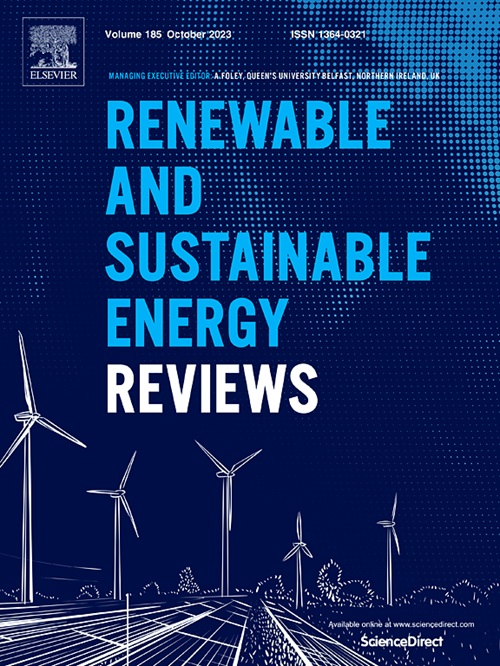用于可持续供需管理和二氧化碳减排的智能多阶段能源排放联系框架
IF 16.3
1区 工程技术
Q1 ENERGY & FUELS
引用次数: 0
摘要
在非经合组织国家,越来越多地采用净负排放(N-NE)技术,如可再生能源、综合碳捕集与封存(CCS)以及潜在的二氧化碳再生,对于解决能源贫困(可持续发展目标7和11)和降低全球二氧化碳排放强度(可持续发展目标13)至关重要。本研究提出了一个可持续能源分配网络(EDN)和二氧化碳减排的智能管理能源-排放联系框架。该框架整合了灵活的需求响应、双向供应监管和碳捕获能力规划,以优化能源性能,避免浪费存储和发电能力。它结合了可持续的交易治理和保护策略,以缓解供应超载,并最大限度地减少二氧化碳排放强度。具有异常检测功能的智能多准则决策(MCDM)程序保证了系统的实时运行和长期的能量排放关联管理。该框架通过越南的一个案例研究得到了验证,表明电力短缺减少了62.25%,存储容量提高了85.1%,ccs驱动的排放限制增加了21.5%。该系统从捕获的二氧化碳排放中再生0.72千瓦时的电力,实现了0.71的稳健可靠率和0.81的消费者满意度得分,高经济能源率为0.05。所提出的战略有效优化了能源分配和二氧化碳减排,有助于提高新兴经济体的能源效率、可持续性和韧性。本文章由计算机程序翻译,如有差异,请以英文原文为准。
Smart multi-stage energy-emission nexus framework for sustainable supply-demand management and CO2 mitigation
The increasing adoption of net-negative emission (N-NE) technologies, such as renewables, integrated carbon capture and storage (CCS), and potential CO2 regeneration, is crucial to address energy poverty (SDG-7 and SDG-11) and reduce global CO2 emission intensity (SDG-13) in non-OECD countries. This study proposes a smart management energy-emission nexus framework for a sustainable energy distribution network (EDN) and CO2 emission mitigation. The framework integrates flexible demand response, bidirectional supply regulation and carbon-capture capacity planning to optimize the energy performance and avoid wasted storage and generation capacity. It incorporates sustainable transaction governance and conservation strategies to mitigate, supply overload, and minimize CO2 emission intensity. A smart multi-criteria decision-making (MCDM) procedure with abnormality detection ensure real-time operation and long-term energy-emission nexus management. The framework is validated through a case study in Vietnam, demonstrating a 62.25 % reduction in electricity shortages, an 85.1 % improvement in storage capacity, and a 21.5 % increase in CCS-driven emission restriction. The system regenerates 0.72 kWh of electricity from captured CO2 emission, achieving a robust reliability rate of 0.71 and a consumer satisfaction score of 0.81 with high economic energy rate of 0.05. The proposed strategies effectively optimize energy distribution and CO2 emission reduction, contributing to enhanced energy efficiency, sustainability, and resilience in emerging economies.
求助全文
通过发布文献求助,成功后即可免费获取论文全文。
去求助
来源期刊

Renewable and Sustainable Energy Reviews
工程技术-能源与燃料
CiteScore
31.20
自引率
5.70%
发文量
1055
审稿时长
62 days
期刊介绍:
The mission of Renewable and Sustainable Energy Reviews is to disseminate the most compelling and pertinent critical insights in renewable and sustainable energy, fostering collaboration among the research community, private sector, and policy and decision makers. The journal aims to exchange challenges, solutions, innovative concepts, and technologies, contributing to sustainable development, the transition to a low-carbon future, and the attainment of emissions targets outlined by the United Nations Framework Convention on Climate Change.
Renewable and Sustainable Energy Reviews publishes a diverse range of content, including review papers, original research, case studies, and analyses of new technologies, all featuring a substantial review component such as critique, comparison, or analysis. Introducing a distinctive paper type, Expert Insights, the journal presents commissioned mini-reviews authored by field leaders, addressing topics of significant interest. Case studies undergo consideration only if they showcase the work's applicability to other regions or contribute valuable insights to the broader field of renewable and sustainable energy. Notably, a bibliographic or literature review lacking critical analysis is deemed unsuitable for publication.
 求助内容:
求助内容: 应助结果提醒方式:
应助结果提醒方式:


